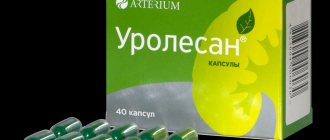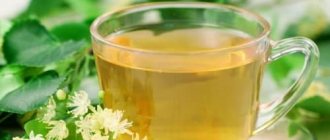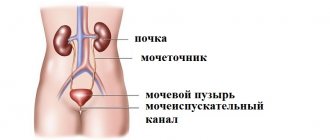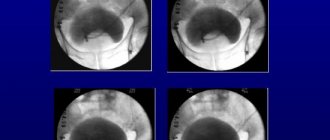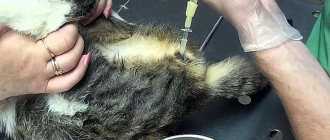Bearberry grows in Siberia, the Far East and the north of our country.
It is a low shrub with small leaves and small red berries that have a mealy taste. The plant is popularly nicknamed bear's ear (probably because the rounded leaves resemble the shape of the ears of a clubfoot and it is the leaves that are used for treatment).
Our ancestors, who were well versed in medicinal herbs, valued bearberry for its ability to help even with advanced cases of cystitis. Now there is no shortage of medicines, but bearberry is still used to treat genitourinary diseases, because many people are convinced of the effective help of this plant. Reviews of bearberry in the treatment of cystitis can be divided into three conditional groups: positive, neutral and negative.
Chemical composition
The effectiveness of bearberry against cystitis is explained by its chemical composition:
- arbutin;
- flavonoids;
- tannins;
- ursolic acid;
- vitamin C.
Arbutin is a glycoside that is converted into the natural antiseptic hydroquinone when it enters the body. The substance has antimicrobial and diuretic effects.
Flavonoids are biological compounds that have a bactericidal effect against pathogenic microflora that causes cystitis.
Ursolic acid is known for its antibacterial and anti-inflammatory properties. Tannins have the ability to suppress the inflammatory process.
Ascorbic acid increases the body's defense reactions, helping to quickly cope with urological disease.
Bearberry decoctions
There are several recipes for making decoctions.
Take 4 tbsp. l. raw materials and fill them with 2 glasses of water. Let the mixture boil. Wrap the resulting broth in a towel and leave to infuse for 20 minutes. The product should be used 1 tbsp. l. every 60 minutes.
Take 10 g of crushed bearberry leaves and pour a glass of water over them. Place the product on the stove and boil it for 20 minutes. Take 1 tbsp. l. three times a day. This decoction should be stored in a dark place.
You can add other useful components to the decoction.
Take 1 tbsp. l. bearberry and add a glass of hot water to it. Let the broth simmer for 5 minutes over low heat in an enamel bowl with a lid. You can add a little baking soda to the finished composition. It will enhance the effect of the plant. Leave the product for a couple of hours. Then pass through a sieve and drink warm half an hour before meals, half a glass three times a day.
- Herbs for cystitis in women - quick treatment
A collection of bear ears and horsetail helps very well. To prepare this collection you will need to take 1 tbsp. l. bearberry, speedwell herb, marshmallow root, sage leaves and 40 g of horsetail. The product is poured into 1 liter of cool water and left for 6 hours, and then boiled for 15 minutes. The finished broth is passed through a sieve and drunk every day in several doses.
After taking bearberry, your urine may turn green. This plant, as it were, washes the urinary tract from inflammation products and disinfects them. It also has an excellent diuretic effect.
Therapeutic effects of “bear ears”
Bearberry leaves for cystitis have the following therapeutic effect on the inflamed mucous membrane of the bladder:
- antiseptic;
- anti-inflammatory;
- regenerating;
- immunostimulating.
Due to the content of diuretic components, the herbal remedy also acts as a diuretic. This in turn allows you to quickly remove pathogenic microflora and speed up the process of remission.
It should be noted that the medicinal plant exhibits therapeutic activity in an alkaline environment, therefore it is recommended to combine the intake of a decoction of the herb with the use of mineral waters or a soda solution. Also, to alkalize urine, you should eat non-acidic apples and pears.
Bearberry is an effective remedy with a long-term reputation
Since time immemorial, ancient Greek medicine has known a plant with the common name “bear ears”, the distinctive property of which is an anti-inflammatory effect on the urinary tract and bladder, normalizing urinary function.
With the help of bearberry you can relieve inflammation of the bladder mucosa
It has been observed that women with impaired diuretic function (cramping and burning during urination, frequent urges, low-grade body temperature, frequent feeling of fullness of the bladder, general malaise and possible intoxication) quickly restore their performance by starting to take an infusion of bearberry (another name for “bearberry”). ears").
At that time, ethyl alcohol was not known, so decoction and tea were used as medicine. The presence of a therapeutic effect was justified only empirically - by observing the positive results of treatment. Today, the mechanism of action of bearberry is explained by what biochemical substances the leaves of the plant are made of and what is the mechanism of their action.
Chemical composition and beneficial properties of bearberry
Bearberry is widely used in folk medicine due to its unique chemical composition. It includes the following components:
- Derivatives of phenol and phenol glycosides: arbutin, hydroquinone, piceoside.
- Tannins.
- Ethers.
- Minerals: I, Zn, Cu, Mn, K, Ca.
- Kakheti.
- Resins.
- Organic acids: gallic, ursulic, malic.
- Flavonoids: quercetin, myricetin.
- Wax.
Flavonoids contained in the leaves of the shrub relieve inflammation and have a powerful antibacterial effect , suppress the development of pathogenic microorganisms, viruses and strains.
Phenol derivatives have a diuretic effect, remove waste and toxins from the human body.
Gallic acid has an antitumor effect and inhibits the growth of cancer cells.
Bearberry has the following healing properties:
- How does lingonberry help with cystitis?
- Relieves inflammation.
- Reduces blood sugar levels.
- Accelerates the regeneration of damaged tissues.
- Has an antioxidant effect.
- Has rejuvenating properties.
- Removes excess water from the body.
- Suppresses the development of bacteria and viruses.
- Eliminates pain and spasms.
- Calms the nervous system.
- Removes waste, toxins, allergens.
How to make a medicinal drink
The instructions contain the following information on how to make a decoction of bearberry for cystitis:
- Place a couple of filter bags in a glass and fill with boiled water.
- Leave to steep for a fifteen-minute period, covering the container with a lid.
- Squeeze out the filter bags and bring the resulting volume to 200 ml.
After the steps described above, the decoction of bear ears is ready for use. The resulting medicine can be stored in the refrigerator for 48 hours. Before drinking bearberry for cystitis, the infusion must be heated until warm.
Recipes for treating cystitis
There are many folk recipes with bearberry for the treatment of cystitis, we will give an example of the most effective ones
Bearberry decoction
Ingredients: 2 tablespoons of dry chopped herbs, half a liter of boiling water.
Method of preparation: add water to the leaves, cook in a water bath for one hour, add boiling water until the original volume is obtained.
Directions for use: Drink 10 milliliters of decoction three to four times a day, forty minutes after eating.
Bearberry infusion
Ingredients: 2 tablespoons of dry chopped herbs, half a liter of clean water.
Method of preparation: cover the leaves with water, leave to infuse for ½ day, then boil for 5 minutes, cool.
- Cystitis in women - symptoms and treatment at home with folk remedies
Directions for use: Drink 10 milliliters of decoction three to four times a day, forty minutes after eating.
To treat cystitis, bearberry can be combined with currant and juniper berries, rose or lavender petals, lingonberries, plantain, rose hips, and nettle leaves. Mix all ingredients in equal proportions and take in the same way as pure decoction and tincture.
Bearberry Recipes
- Decoction. To prepare it, you need to take a tablespoon of previously crushed leaves and pour boiling water over them (one mug will be enough). After fifty minutes, the broth is filtered, after which it must be cooled to room temperature.
- Infusion. Pour a tablespoon of dried bearberry flowers into a thermos and pour 150 milliliters of boiling water over them. The mixture should be brewed and left overnight. In the morning, the finished medicine is filtered. It is advisable to pour the infusion into a glass container.
- Alcohol infusion. One hundred milliliters of alcohol is added to two tablespoons of bearberry leaves. The tincture from the “ears” will be ready in a couple of weeks. The mixture must be thoroughly strained before use.
- Bearberry herbal tea. One dessert spoon is poured with four tablespoons of clean water, after which the resulting mixture must be boiled over fire for ten minutes. You can drink this medicine like regular tea.
How to use for cystitis
Bearberry flowers, leaves and roots are used to make herbal drinks. The effect of these drugs is aimed at eliminating diseases of the genitourinary system and lesions of the gastrointestinal tract; good results with the use of Bear's Ear are recorded in the treatment of heart failure, edema, stopping uterine bleeding and combating the symptoms of cystitis in patients with an alkaline urine reaction.
The medicinal properties of bearberry have an amazing effect and are even superior to some medications, while having virtually no contraindications or side effects, which is especially important during the treatment of bladder inflammation. The treatment process must begin with a consultation with a doctor in order to avoid mistakes and abuses that lead to worsening damage to the body.
Only a doctor will be able to determine the dosage of decoctions and infusions, taking into account the patient’s age, gender and weight. The following admission rules are recommended for adult men and girls:
The treatment process must begin with a consultation with a doctor in order to avoid mistakes and abuses that lead to worsening damage to the body. Only a doctor will be able to determine the dosage of decoctions and infusions, taking into account the patient’s age, gender and weight. The following admission rules are recommended for adult men and girls:
- Bearberry alcohol tincture is taken 15 drops three times a day after meals;
- tea is consumed half a glass up to four times a day, without connection with meals;
- It is recommended to drink the decoction before meals, one tablespoon three times a day.
Children are prohibited from drinking alcoholic tinctures, and tea based on Bear's Ears should be taken only as prescribed by a doctor, following his instructions in limiting daily doses.
Indications and contraindications for use
In folk medicine, the leaves of the bush are often used; they are used to eliminate the following pathologies:
- Renal dysfunction: nephritis, pyelonephritis.
- Cystitis.
- Disease of the gastrointestinal tract.
- Rheumatism.
- Oncological diseases.
- Inflammation of the prostate gland.
- Atherosclerosis.
- Tuberculosis.
- Gout.
- Neuroses, insomnia.
- Diabetes.
- Fatigue.
- Gastritis, ulcer.
- Conjunctivitis.
Bear ears relieve swelling well, remove excess fluid from the body, and therefore are an indispensable component for the treatment of pathologies of the urinary system.
The plant helps cope with nervous disorders, eliminates insomnia and anxiety.
Bearberry helps relieve the symptoms of prostatitis in a short time. Relieves spasms, pain from rheumatism, cancer. It has an astringent effect for digestive disorders and colitis.
A large number of pharmaceuticals are produced based on the shrub: Urokam , Ursul , Uriflan . These drugs are intended to treat diseases of the urinary system.
Like all medicinal plants, bear ears have a number of contraindications for use:
- Age up to 12 years.
- Pregnancy and breastfeeding.
- Acute renal failure.
- Allergic reactions and individual intolerance to components.
If the dosage is not observed, side effects may occur: nausea, headache.
To prevent side effects, you should stick to a diet and exclude protein foods from your diet.
It is forbidden to simultaneously take drugs containing alkali and alkaloids.
Healing properties of bearberry
Bearberry (bear's ear, bearberry) is a shrub with dark green leaves and red berries that grows in the USA and Siberia. The fruits of the plant are characterized by a sharp taste. For therapeutic purposes, the leaves of the bush are used, which have a number of medicinal properties:
- antiseptic;
- painkiller;
- antibacterial;
- anti-inflammatory;
- sedative;
- diuretic.
The described healing qualities are due to the rich composition of bearberry: vitamins, minerals, organic and tannins, essential oils, salts.
Adverse reactions
Before taking bearberry for cystitis, you should familiarize yourself with the adverse reactions that the herbal remedy can provoke. Most often, the use of herbal medicine causes:
- nausea;
- vomiting;
- loose stools;
- allergies.
When treating cystitis with bearberry, you should be prepared for the urine to turn dark green. After discontinuation of the drug, the color of the urine is restored.
In the presence of chronic kidney pathologies, their exacerbation may occur while taking the herbal drug due to its ability to irritate the renal tubules.
What is valuable in bearberry leaves
Bearberry for cystitis - anti-inflammatory, astringent, disinfectant, antiseptic effect. What does this treatment mechanism provide?
The leaves of the plant are of particular medicinal importance.
Today, the presence of a phenolic-type glycoside, arbutin, has been precisely established in their composition. This component has antimicrobial properties, especially against mycoplasmas - bacteria that have a tropism for urological organs.
Thanks to its action, the bacteria that caused the pathological process are destroyed, the products of their vital activity and decay cease to poison the body, causing intoxication.
The mucous membrane receives an incentive to restore its normal structure. Regeneration of damaged blood vessels occurs, due to which blood impurities are removed from the urine.
In addition, bearberry leaves contain flavonoids, which enhance diuresis, accelerating the removal of chlorine and sodium from the body. This is why urine may turn dark green when using bearberry.
Infusions for the treatment of cystitis
To properly make bearberry infusion, you need to follow the recipe. Since the slightest deviation from the instructions can aggravate the course of the disease or cause an unpredictable reaction in the body. During the period of consuming infusions from the leaves of the bush, you need to monitor your well-being.
Infusion from the plant
Pour boiling water over the plant placed in a thermos and let it stand. Take the resulting product after meals, one tablespoon four times a day. Long-term use can cause vomiting, nausea, and diarrhea. In this case, you should stop using the solution.
Cold medicine
Pour 10 gr. bearberry in 400 ml of cold water. Stir and leave for half a day. Before use, warm the product slightly and strain. Use 30 ml of infusion after meals three times a day.
This preparation option extracts all the active substances from the plant, since there is no thermal effect.
Warm cold medicine over low heat before use.
Alcohol version
Pour two tablespoons of dried bush leaves with 100 ml of alcohol or vodka. Infuse the solution for two weeks. Before use, it is necessary to strain the liquid and consume a teaspoon three times a day.
Herbal collection
It is recommended to combine the leaves of the bush with celandine, birch leaves, and parsley.
Mix a teaspoon of dried parsley and celandine with two tablespoons of bearberry and hernia. Pour 300 ml of boiling water over the plant mixture and leave for an hour. Take this infusion of bearberry, 50 ml three times a day after meals.
Modern uses of bearberry
Today's recipes for preparing medicinal compositions from bearberry are not much different from previous times. True, alcohol tinctures are the most popular, although infusions and decoctions are also popular.
The positive aspect of treatment with tinctures is the absence of a heat factor when preparing the medicine, which means maximum preservation of the therapeutic composition.
However, alcohol tincture may be contraindicated if the disease is in an acute stage and occurs with obvious organic pathologies. And it takes time to prepare an alcohol solution, which also excludes it in the acute phase.
The water infusion, of course, is inferior to the alcohol infusion in terms of its shelf life; it must be used within 24 hours from the moment of preparation. Therefore, you should worry about the timing of its preparation in advance.
Preparing a bearberry decoction is not difficult, but the main points must be observed:
The leaves should be finely chopped. The proportion is 5 g per 100 ml of water at room temperature. The boiling process should last 15 minutes, after which the broth cools and filters.
Bearberry is used in the form of decoctions and teas
The recipe for making the infusion is slightly different. In this case, the leaves are poured with boiling water and boiled for 5 minutes. Leave for 40 minutes and only then strain. The recommended dose is one tablespoon four times a day.
The packaging of bearberry tea in bags, offered today by the pharmaceutical chain, is very convenient, allowing you to quickly and efficiently prepare a glass of medicinal tea. The crushed leaves are placed in appropriate packaging and a bag per glass is recommended.
To give the medicine a taste, you can use the decoction to make jelly. This is especially true for children. It is prepared simply, with the addition of starch according to the recipe. Of course, the active principle of such a medicine is reduced and it requires compensation in quantity.
Today, a new method of preparing kidney tea from bearberry has proven well - cold infusion. Such a product, even more than a decoction, has a therapeutic effect, since all active ingredients, including leaves, retain their properties. In addition, there is no bitter unpleasant taste.
Alcohol tincture of bearberry for cystitis
For half a glass of diluted medical alcohol to 40% strength, you will need a couple of tablespoons of the main component. The tightly closed container with the medicinal solution is placed in a cool, dark place for two weeks. The tincture is shaken periodically throughout the infusion time. After the product is ready, take 10 drops up to three times a day after meals.
The tincture is often used as an additional remedy for the chronic course of the disease, as well as for prophylactic purposes to reduce the frequency of exacerbations.
How to take bearberry for cystitis
The most effective remedies from bearberry are alcohol tincture, decoction, infusion. But alcohol tincture is prohibited for use in severe cystitis. For inflammation of the bladder, decoctions of bearberry are effective.
Prepared infusions and decoctions from the plant relieve pain from cystitis and fight infections of the urinary system. Due to the content of flavonoids, bearberry affects diuresis, eliminating sodium and potassium ions. The diuretic effect of the shrub is due to the phenols it contains, which have an irritating effect on kidney tissue, increasing the secretion of urine.
Interesting! Armenian medicine during the Middle Ages used bearberry to treat hemoptysis and diarrhea.
Prepared products from the plant have an astringent and antiseptic effect, which allows them to be used for diabetes, diarrhea, and tuberculosis. And to get rid of gastritis and diarrhea, decoctions of fruits in milk are used.
At the same time as taking the medicinal plant, you need to eat fresh vegetables, fruits, and drink more liquid.
When treating cystitis with bearberry, it is prohibited to consume:
- alcoholic drinks;
- sparkling water;
- coffee;
- fatty, smoked foods.
Consult your doctor for advice before starting treatment.
Patient reviews
There are a huge number of reviews on the Internet about the use of bearberry for the treatment of cystitis. Here are some of them:
- Olga, 37 years old : “I have been using bearberry for more than 4 years, at the moment I have forgotten what cystitis is. This plant is always present in the home medicine cabinet. Combined use with no-shpa allows you to relieve the symptoms of the disease in a few hours.”
- Anna, 27 years old : “Unfortunately, the miracle plant did not help me. Experts explained to me that bear ears will not help as long as the urine reaction is alkaline. Therefore, after taking the course, there was no improvement.”
- Maria, 43 years old : “My grandparents used bear ears to treat inflammation of the bladder. Every summer I myself prepare the leaves of this plant and, when the first symptoms of the disease appear, I immediately drink a decoction based on them.”
- Yulia, 39 years old : “With the onset of cold weather, my cystitis always worsens. For the past two years I have been using bearberry to treat this ailment. It tastes disgusting, but the effect comes immediately.”
( 1 ratings, average: 5.00 out of 5)
Preparations based on bearberry
In the pharmacy you can find herbal remedies that contain bear's ear herb. These include:
- Uriflorin;
- Lessons.
These herbal medicines have different release forms and differ in composition.
Uriflorin
The medicine is available in the form of tablets, the main active ingredient of which is bearberry extract. It is used in complex therapy of inflammation of the bladder and urinary tract.
In acute cases of the disease, take a tablet at 30-minute intervals after meals. The daily dosage is three tablets. The course of treatment lasts for 21 days. Then take a 10-day break and repeat therapy if necessary. For preventive purposes, the drug can be taken up to 4 times a year.
Lessons
The drug is available in the form of a syrup, the active ingredients of which are:
- birch leaves;
- lingonberry extract;
- cranberry fruits;
- extract from bear ears.
By secret
Incredible... Chronic cystitis can be cured forever! This time. Without taking antibiotics! That's two. During the week! That's three.
Follow the link and find out how our subscribers do it!
It is important to know! ×
There are diseases that appear suddenly, develop quickly and are fraught with consequences. They interfere with normal life, prevent you from leaving the house for a long time, spoil your mood and require immediate therapy.
If inflammation develops in the bladder, treatment should be started as soon as possible
These include cystitis - inflammation of the mucous membrane of the bladder and partially the urinary tract. The causes of the disease are various:
Exo- and endogenous infections. Complications after colds. Consequences of instrumental examinations of the pelvic organs. Frequent allergic reactions. Injuries.
There are no differential diagnostic problems. Typical signs of cystitis cannot be confused with anything. The main thing is to start treatment on time.
Bearberry for cystitis: how to take?
There are two approaches to treating cystitis with bearberry. The first is the use of pharmaceutical preparations prepared on its basis. The second is the use of decoctions and infusions prepared at home. In the latter case, you take ready-made raw materials purchased at a pharmacy, or you collect the grass yourself, dry it and store it for future use.
Bearberry leaves can be bought at the pharmacy
You can make water- or alcohol-based medicines at home. In most cases, water infusions or decoctions are preferable, as they have fewer side effects, but do not last long. Alcohol infusions are contraindicated for some people and are incompatible with many medications.
You need to take the prepared products in accordance with the correct dosage, like any other medicine. As a rule, alcohol infusions are consumed in an amount of 10-15 drops, three times a day.
Bearberry tea is drunk up to 4 times a day, 2/3 cup each. The daily dose of the decoction is up to 45 ml, the water infusion is taken 10-15 ml three times a day.
These are universal rules, but for each patient the optimal dose must be determined individually. To do this, you need to consult your doctor.
This plant can not only eliminate the main manifestations and cause of the disease, but also prevent the development of complications or the transition of the disease to a chronic form. Therefore, it is advisable not to stop using it immediately after the symptoms disappear; the full course lasts a couple of weeks. Your doctor will tell you the exact duration of treatment.
Bearberry is not recommended for everyone: use for cystitis in children under 12 years of age and in women during pregnancy and lactation is not recommended. Special warnings for patients with kidney pathologies. Treatment with bearberry is stopped if side effects appear: vomiting, indigestion, fever. While taking medications, your urine may change color to green.
Despite the complex effect, cystitis cannot be treated only with bearberry - it is only an addition to the main drug therapy.
What are the benefits of kidney drops?
Diseases in the field of urology are quite common today. Such diseases do not have pronounced symptoms or severe pain, such as with diseases of the urinary system.
The difficulty is that when ignored, or rather unaware of the onset of the disease, an exacerbation occurs, then a more comprehensive approach is required.
In order to be fully cured, in addition to medications, herbal decoctions, infusions, and drops are often prescribed. The holistic complex helps to get rid of the consequences of the disease. Canephron is a kidney drop that belongs to these drugs.
Characteristic
Quite in demand and popular in the field of urology, the kidney medicine Canephron. It, together with other medicines, treats the disease.
The drug contains herbal remedies, which include centaury herbs, lovage root, and rosemary. The drug must be taken orally, just like pills. In addition to the herbal composition, the drug contains corn starch and silicon dioxide. In addition, the medicine is rich in sucrose, titanium dioxide, iron oxide, and dextrose.
The drug has a characteristic aroma and, according to its external characteristics, has a yellow, possibly brown tint. If the medicine is stored for a long time, then precipitation may occur. The shape of the dragee is round, slightly convex, and the color is orange.
The mechanism of action of the drug is that with regular use, the loss of protein components in the urine is reduced, that is, the level of permeability of the renal capillaries is reduced. The drug also has a relaxing effect on the human body, inflammatory processes are significantly reduced. Acts as an antiseptic and diuretic, while maintaining the normal functionality of the body and the integrity of water-salt processes.
The positive side of this drug is that it has a gentle effect on the human body. The result is observed a little later than when taking other medications, but the effect of such a complex therapeutic course is persistent.
Indications for use
Canephron should be taken when specialists have discovered:
- damage in the area of the bladder, kidney organs;
- reactions of an allergic, infectious nature, inflammatory processes of chronic manifestations in the kidneys;
- The drug is used for prevention; it minimizes the risk of kidney stones in the future.
In addition to these disorders, the drug is prescribed:
- with pain in the lumbar region, characteristic fatigue of the whole body, rapid fatigue and decreased desire to eat, all these symptoms are accompanied by a severe headache;
- swelling that accompanies a person in the morning, deviation from normal blood pressure;
- Blood appears in the urine, severe pain is felt when urinating, and a burning sensation is possible during this process.
Application
Canephron drops and tablets - instructions for use are quite simple. In the case of drops, they should be diluted a little with water before taking. The jar of medicine itself must be shaken before use. Don't stop taking it. It is important to take the medicine for two to three weeks after treating an acute, advanced form.
The dragee should be taken by children from seven years of age and adults, respectively, 1 and 3 tablets three times a day, half an hour before meals, throughout the entire period of the disease. After this, you should continue taking it for two, perhaps four weeks.
The solution can be taken by children from one year old in the amount of 15 drops, children from seven years old by 25 drops. For adults, the dosage is slightly higher - 50 drops. Throughout the entire acute period of the disease, take the solution three times a day, half an hour before meals, then similarly for 2-4 weeks after that.
Note! It is possible to increase the positive effect of the drug on the body by drinking a normal volume of water (1.5 - 2 liters). By using it in the urine, unnecessary bacteria, inflammatory products, and salts are eliminated faster.
Contraindications for use
The medicine is herbal based, but despite this fact, it has contraindications for use:
- if the patient has a particular sensitivity to one of the components of the herbal base of the drug, then it should not be used for treatment;
- during the period of exacerbation of stomach ulcers, avoid using the drug, all because of the alcohol content;
- For the same reason, categories of people who have suffered from alcoholism for a long time should avoid drugs containing alcohol. Some groups of people react quite aggressively to such a small amount;
- Contraindicated for use by people suffering from lactose and fructose intolerance;
- Children should not take the drug. In consultation with a doctor, it is possible to take it after one year, not earlier. When taken as a whole, the medicine is safe in nature and does not cause any harm to children over six years of age;
- It is necessary to take the drug with extreme caution, after consulting with your doctor, to people who suffer from liver damage or have a traumatic brain injury.
Reception security
Due to its largely herbal composition, the drug is considered safe in nature. Side effects that may still occur manifest themselves in the form of allergies, or attacks of nausea and vomiting. If you observe at least one of these symptoms, then you should stop taking it, it may simply not be suitable for you.
Separately, it is worth discussing the interaction of this drug with other medications. This issue has not been sufficiently studied, but it is known that the effectiveness of the drug increases when it is supplemented with antibacterial agents.
Pregnant women or nursing mothers can also take the drug; there are no special contraindications in this area.
It is important to remember that the drops contain a small amount of alcohol. That is, when driving a car, you should use the drug in moderation and at a certain time.
Tablets are also used for cystitis. They are necessary for complex treatment. Monotherapy with this drug is prescribed for chronic disease during a remission period.
Among the analogues of the drug are Cyston, Phytozin, Furagin. Only a doctor can determine which drug you need. When choosing a medicine, you should not rely on reviews, or on the integrity of the price range of the drug. It is worth going through the full course of treatment.
Cost of the drug
This drug has an affordable price for a wide range of consumers. Due to its prevalence, the drug can be found in any pharmacy.
The price range of the dragee fluctuates around 330 rubles. One such package contains 60 pieces of dragees.
The price range of drops is 100 rubles. One bottle has a capacity of 100 ml.
There is no significant difference in price or properties between these two forms of release of the drug. Therefore, in comparison, they are approximately equivalent to each other.
conclusions
Canephron is a fairly common remedy in the fight against many diseases. That is why you can read so many reviews. Mostly positive feedback about taking the drug. This is not surprising, because its composition is plant-based and has a gentle and effective effect on the human body.
People who took the course are satisfied with the results. There are contraindications, but their number is insignificant. Also, do not forget about the possible side effects of use.
The drug can be used for pregnant women and women who are breastfeeding.
Remember that, despite the positive reviews, the safe composition and effective action of the drug, you should consult your doctor before using it. Only he can prescribe you a holistic course that will include several aspects. Only in this way will you forget about the disease.
Use for cystitis
Cystitis is an inflammation of the bladder. The disease is caused by opportunistic and pathogenic microorganisms: staphylococcus, E. coli, streptococcus, Proteus and many others. Women are most susceptible to the disease.
Bearberry has been used since ancient times to treat cystitis. It has antibacterial, antiseptic, and diuretic effects.
To achieve the greatest therapeutic effect, you need to drink at least 2 liters of liquid daily and eat as many fresh vegetables and fruits as possible.
During the treatment period, it is prohibited to consume alcoholic beverages, coffee, cocoa, carbonated drinks, spicy, salty, smoked foods.
Bear ears are taken in the form of decoction, infusion and tea.
The decoction allows you to quickly relieve the symptoms of the disease. To prepare it, you need to brew 10 grams of shrub leaves with 250 ml of water, boil, and leave for 40-50 minutes. Take 10 ml 5-6 times a day. The course of treatment is 10-14 days.
The infusion has an antibacterial effect, inhibits the development of microorganisms and disinfects the genitourinary tract. To prepare, you need 15 grams of bear ears, pour 200 ml of boiling water, leave for 10-12 hours. Take the resulting liquid 100 ml three times a day.
Alcohol infusion is an excellent preventive measure. To prepare, you need to pour 50 grams of bear ears with a glass of vodka, seal it tightly and leave for 10-14 days in a dark place. The infusion is taken 15-20 drops three times a day.
Bearberry is used together with other medicinal herbs; they enhance each other’s effects and the patient recovers faster.
Collecting bear ears with horsetail is the most popular; the infusion is prepared as follows: pour 10 grams of each plant into a liter of boiling water, bring to a boil, and cool. Drink 10-20 ml every 2 hours.
Corn silk with bearberry relieves pain and spasms. To prepare the infusion, add 15 grams of plants to 200 ml of water, bring to a boil, and cool. Take 50 ml 4 times a day.
